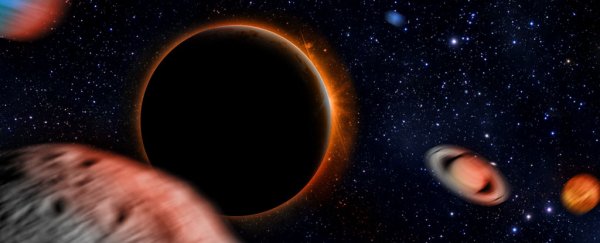While it's hard not to get excited about the prospect of Planet Nine – the hypothetical world scientists are trying to find at the outskirts of the Solar System – a new study suggests that it might not all be good news, as far as the rest of the Solar System is concerned.
A scientist in the UK has calculated that in the very far future, when our Sun is dying, the existence of Planet Nine could pose a danger to other planets in our stellar neighbourhood – and may ultimately eject one or more from the Solar System.
Earlier this year, astronomers announced evidence of a massive cosmic body beyond the orbit of Neptune, suggesting that there could be a ninth planet lurking in the Solar System.
The evidence is based on the movement of rocky objects in the Kuiper Belt at the edge of the Solar System, which suggests the gravitational presence of a huge, unseen mass that scientists had previously never accounted for.
Now astrophysicist Dimitri Veras from the University of Warwick says that this huge mass could complicate things for other planets in the Solar System several billion years in the future, when the Sun begins its transformation into a white dwarf.
But before we get into that, let's backtrack a little, as an idea of what Planet Nine is – or rather, could be – is helpful to understanding why it could ultimately cause havoc for its planetary neighbours.
It's thought that Planet Nine could be 10 times more massive than Earth and four times the size, and the astronomers who detected the Kuiper Belt anomalies think the planet orbits the Sun on a gigantic loop that takes it somewhere between 10,000 to 20,000 years to complete.
While the case for Planet Nine remains very much hypothetical at this point, it's a case that's getting stronger all the time, as researchers keep finding more and more evidence to back up the potential existence of this massive world.
Back in March, researchers found new Kuiper Belt Objects that support the hypothesis, and just yesterday, they found even more.
But Veras now thinks that the mass and far-out orbit of Planet Nine could bring it into conflict with the movement of other planets in the Solar System when the Sun transitions from a red giant to a white giant in around 7 billion years or so.
When this process happens, the red giant Sun will eject half of its own mass and inflate itself, consuming Mercury, Venus, and, uh, Earth in the process, and then fade into a faint, dense white dwarf.
As the Sun ejects its mass, it's expected that Jupiter, Saturn, Uranus, and Neptune will all be pushed away from it – but because Planet Nine is already located so far away, Veras thinks it won't be pushed out like the other planets. Instead, he calculates Planet Nine could be drawn into a kind of 'death dance' with the newly positioned planets, especially Uranus and Neptune.
"The existence of a distant massive planet could fundamentally change the fate of the Solar System," says Veras. "Uranus and Neptune in particular may no longer be safe from the death throes of the Sun. The fate of the Solar System would depend on the mass and orbital properties of Planet Nine, if it exists."
Of course, the kind of 'fate' we're talking about here is a very distant one, since life on Earth would have already been wiped out by the inflating Sun – meaning your own personal care factor for the cosmic trajectories of the Solar System's remaining worlds is probably pretty low anyway.
Veras suggests that gravitational interactions between Planet Nine and the post-Sun orbits of Uranus and Neptune could potentially lead to the latter planets being ejected from the Solar System themselves.
It's a fascinating idea, but we'll have to wait until we know more about the veracity of Planet Nine before we get too committed to this particular post-doomsday-doom scenario.
Although, if the findings are accurate, it could provide a strange coda to at least one hypothesis around how Planet Nine came to be in our Solar System in the first place.
Earlier in the year, another team of researchers calculated that this mystery planet may have once existed as an exoplanet orbiting another star, but came to be sucked into our Solar System during a close encounter between the two planetary systems some 4.5 billion years ago.
And look at Planet Nine now, storming around like it owns the place.
The findings have been accepted for publication in an upcoming edition of the Monthly Notices of the Royal Astronomical Society, but you can read them online at pre-print website arXiv.org.
